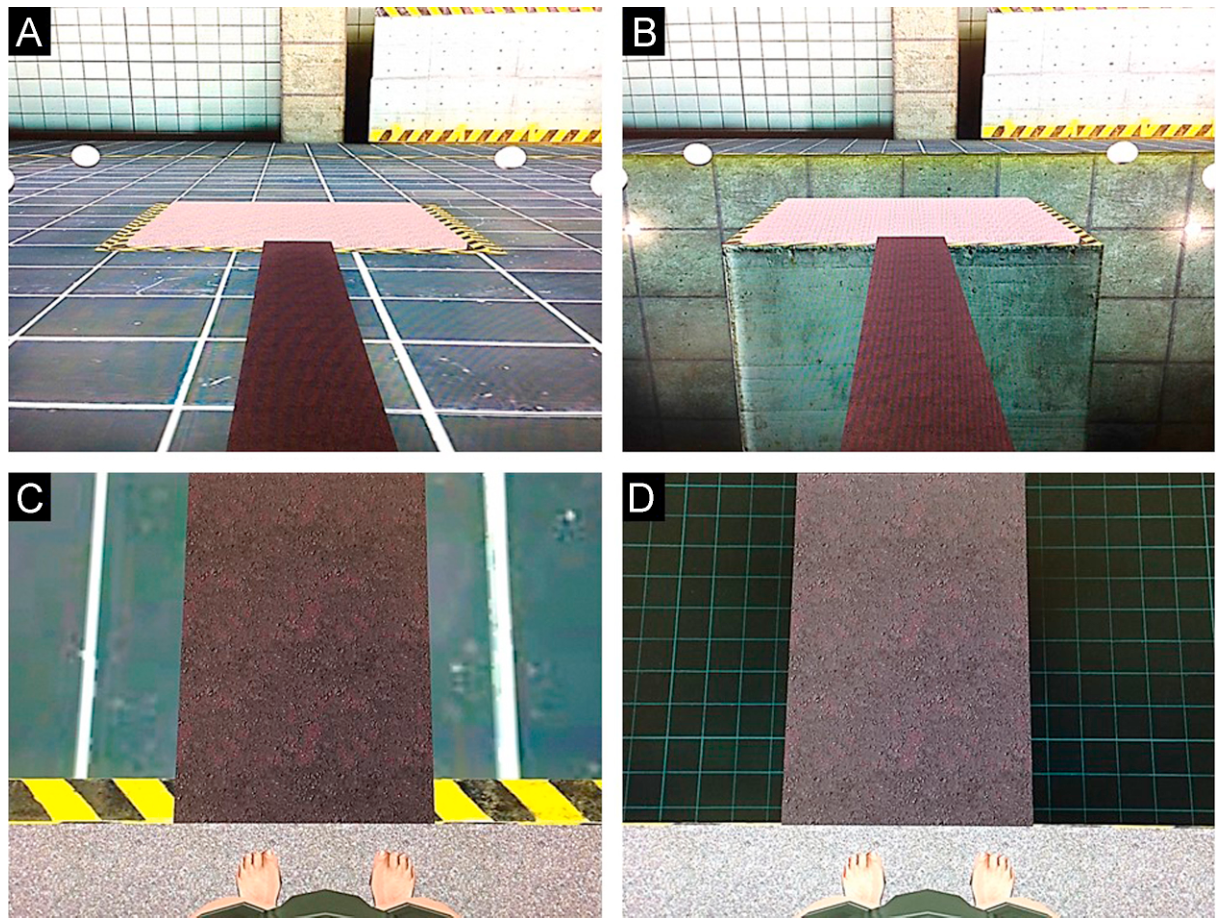Generalized anxiety affects about half of individuals suffering from Parkinson’s disease (PD). Research has demonstrated that anxiety impacts mobility and quality of life, and in PD it can even trigger severe deficits like freezing of gait. The present study used virtual reality to examine howanxiety induced these observable deficits. The virtual environment was manipulated by experimentally inducing a postural threat, under four conditions (see Figure 1). Participants were asked to walk across a plank that was either located on the ground or elevated above a deep pit, and with or without visual feedback about their lower limbs. This experimental set-up aimed to investigate whether processing of (i) threat-related aspects of the environment or (ii) sensory feedback was disrupted in anxiety-provoking situations. In addition, we also investigated the role of dopaminergic medication on these processes in PD, as it remains controversial whether anxiety (and impairments induced by anxiety) respond to dopaminergic therapy.

Figure 1. Virtual reality protocol: A) Ground plank, B) Elevated plank. This figure also illustrates conditions where visual feedback was made available to participants (C and D).
Forty-eight participants (24 older adults; 12 Low Anxious PD, 12 Highly Anxious) completed 20 walking trials in our virtual reality context. All participants reported greater levels of anxiety when walking across the elevated plank compared to the plank on the ground. Highly Anxious PD participants demonstrated greater gait impairments (e.g. increased variability) under threatening conditions compared to the other groups. Interestingly, participants’ accuracy of their perceived walking performance improved under conditions of increased threat. Highly anxious PD (in their OFF state) were unable to use sensory feedback to reduce gait variability when walking across the elevated plank, unlike the low anxious PD. However, once the highly anxious PD were ON their dopaminergic medication, an improvement in gait variability was seen, especially when sensory feedback was provided.
Higher levels of anxiety in PD may influence gait performance by competing for shared central processing resources and disrupting the ability to use sensory feedback to adapt their gait if needed. Highly anxious individuals with PD might be particularly susceptible to this interference with information processing, resulting in exacerbated gait impairments, especially in threatening situations. Our results are hopeful that dopaminergic treatment may reduce anxiety and/or improve resource capacity for sensorimotor processing in these highly anxious individuals. These findings have both practical and clinical implications for developing new gait rehabilitation therapies in PD. For example, novel treatments aimed at reducing levels of anxiety may, if effective, also lead to reductions in gait deficits, freezing and even falls.
Publication
Ehgoetz Martens, K.A., Ellard, C.G., Almeida, Q.J. (2015) Virtually-induced threat in Parkinson’s: Dopaminergic interactions between anxiety and sensory-perceptual processing while walking. Neuropsychologia, 79, 322-31.
http://www.sciencedirect.com/science/article/pii/S0028393215300361
About the Author

Kaylena A. Ehgoetz Martens
Brain and Mind Research Institute, Faculty of Medicine, University of Sydney
Kaylena Ehgoetz Martens’ main research interests are focused on how brain dysfunction leads to severe walking impairments in neurodegenerative disorders (e.g. freezing of gait (FOG) in Parkinson’s disease (PD)). She currently has a particular interest in how stressful environments might overload the brain’s capacity, and consequently modify sensory processing, perception and action.
Kaylena is currently a postdoctoral fellow at the Brain and Mind Research Institute, Department of Medicine at the University of Sydney. The study she presented here she performed as part of her doctoral work at the Department of Psychology, University of Waterloo in collaboration with the Movement Disorders Research and Rehabilitation Centre, Wilfrid Laurier University.
Copyright
© 2018 by the author. Except as otherwise noted, the ISPGR blog, including its text and figures, is licensed under a Creative Commons Attribution-ShareAlike 4.0 International License. To view a copy of this license, visit https://creativecommons.org/licenses/by-sa/4.0/legalcode.
ISPGR blog (ISSN 2561-4703)
Are you interested in writing a blog post for the ISPGR website? If so, please email the ISGPR Secretariat with the following information:
- First and Last Name
- Institution/Affiliation
- Paper you will be referencing
